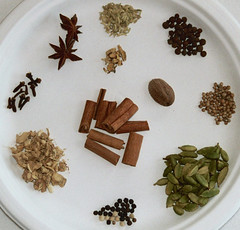 |
| Sliced |
 |
| Sliced 2 |
 |
| 15 oz spud |
 |
| Before the slice |
 |
| Oh, the agony! |
 |
| 11 oz spud |
 |
| Mashed and water |
 |
| Savories! |
 |
| Yes – orange peel! |
 |
| Pre-bake |
 |
| Cooling |
 |
| Tasting |
 |
| Slicing |
 |
| Criticising |
Yep, folks, it’s time for the monthly Daring Bakers challenge! For this month we were supposed to make potato bread. We were to start out with a smallish amount of potato if we’re not experienced at making potato bread; thanks for that challenge, by the way Tanna, which assured that I would take the bait and cram as many potatoes into the bread as possible. 😉
All kidding aside, it would have been wise for me to start out with the 8 oz of potato recommended, but I tried for the full 16. The first time ’round, I boiled the potatoes, let them sit … and they turned kinda funky (technical term: rotten and stringy, because I forgot them over night) Alas, the cosmos (and organic gardening) were truly against me, as the truly mighty spud I selected for the next attempt turned out to have a dark heart! After trimming and pruning I ended up with around 10 oz of potato, which I duly boiled & saved the water from. The instructions were (thankfully) not so strict this time around, so I felt that I was within regulations by including some olives, onion, rosemary, and orange peel in the loaves (she said they had to be savory).
This was the first time ’round for our pizza stone over here in the UK, despite having installed it into the oven quite some time ago. I just … well, have been scared for it, considering the generally wimpy nature of the oven. So, onto the stone they went, 4 loaves … which didn’t really want to all fit onto the stone, and which didn’t have enough elbowroom nor enough space to just hang over the edges a little. So, with much squeezing, they all shared the stone, and turned out … well, tasty, but not so perfect.
In the future, I’ll be doing a smaller batch lying to you, saying I’ll do a smaller batch, when I’ll be just wishing that I had, complaining about the batch size, and making excuses. Hrumph. Yes. Well. Perhaps, though, I’ll try to see if there’s a better position for the stone in the oven, as the bottoms of the loaves didn’t get done as darkly as I thought they should have, while the top-crust formed quite a few bubbles just beneath the crust, which says to me that the heat was coming from the top rather than from beneath, as it should with a stone. So, I figure that the stone didn’t do its job. Maybe it’s something to do with it being a convection oven? Anybody have any ideas?
The bread was quite tasty, tender, and generally wonderful. The rise was a bit abysmally slow, and I attribute that to the fact that I forgot to use something other than tap water in which to boil the potatoes. So, the poor wee yeasts were struggling for life with chlorine, not to mention that they’re this strange yeast we find over here, and that I’m not used to. I’ve one more can of the stuff, and then I’m switching back to my vacuum-sealed brick of yeast brought along from the US, which is quite familiar to me, if rather flavorless.
As far as what happened to these loaves, one of them went over to Holler, and the others … vanished mysteriously. Quite rapidly. Probably too rapidly. This type of thing is why we used to give bread away to our neighbors, but since we’re in the UK now, we’ll probably not have anybody to share with for another decade or so. 😉
So, enjoy the other versions, and thanks for listening to me ramble on about bread once again! Can you tell that we like it, over here?




























































